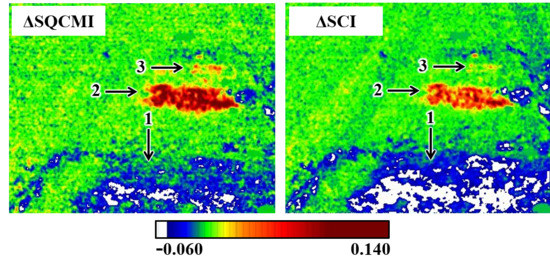Application of Hyperspectral Remote Sensing in the Longwave Infrared Region to Assess the Influence of Dust from the Desert on Soil Surface Mineralogy
Abstract
1. Introduction
2. Materials and Methods
3. Results and Discussion
3.1. Ground-Based Data
3.2. Field-Based Data
4. Conclusions
Author Contributions
Funding
Conflicts of Interest
References
- Offer, Z.Y.; Zaady, E.; Shachak, M. Aeolian Particle Input to the Soil Surface at the Northern Limit of the Negev Desert. Arid Land Res. Manag. 1998, 12, 55–62. [Google Scholar] [CrossRef]
- Singer, A. Soils of the Negev. In The Soils of Israel, 1st ed.; Springer: Berlin/Heidelberg, Germany, 2007; pp. 52–74. [Google Scholar] [CrossRef]
- Cudahy, T.J.; Whitbourn, L.B.; Connor, P.M.; Mason, P.; Phillips, R.N. Mapping surface mineralogy and scattering behavior using backscattered reflectance from a hyperspectral midinfrared airborne CO/sub 2/laser system (MIRACO/sub 2/LAS). IEEE Trans. Geosci. Remote Sens. 1999, 37, 2019–2034. [Google Scholar] [CrossRef]
- Vaughan, R.G.; Calvin, W.M.; Taranik, J.V. SEBASS hyperspectral thermal infrared data: Surface emissivity measurement and mineral mapping. Remote Sens. Environ. 2003, 85, 48–63. [Google Scholar] [CrossRef]
- Notesco, G.; Ogen, Y.; Ben-Dor, E. Mineral classification of Makhtesh Ramon in Israel using hyperspectral longwave infrared (LWIR) remote-sensing data. Remote Sens. 2015, 7, 12282–12296. [Google Scholar] [CrossRef]
- McDowell, M.L.; Kruse, F.A. Integrated visible to near infrared, short wave infrared, and long wave infrared spectral analysis for surface composition mapping near Mountain Pass, California. In Algorithms and Technologies for Multispectral, Hyperspectral, and Ultraspectral Imagery XX; Velez-Reyes, M., Kruse, F.A., Eds.; SPIE Press: Bellingham, DC, USA, 2015; Volume 9472. [Google Scholar] [CrossRef]
- Aslett, Z.; Taranik, J.V.; Riley, D.N. Mapping rock forming minerals at Boundary Canyon, Death Valey National Park, California, using aerial SEBASS thermal infrared hyperspectral image data. Int. J. Appl. Earth Obs. Geoinf. 2018, 64, 326–339. [Google Scholar] [CrossRef]
- Hecker, C.; van Ruitenbeek, F.J.A.; Bakker, W.H.; Fagbohun, B.J.; Riley, D.; van der Werff, H.M.A.; van der Meer, F.D. Mapping the wavelength position of mineral features in hyperspectral thermal infrared data. Int. J. Appl. Earth Obs. Geoinf. 2019, 79, 133–140. [Google Scholar] [CrossRef]
- Notesco, G.; Weksler, S.; Ben-Dor, E. Mineral Classification of Soils Using Hyperspectral Longwave Infrared (LWIR) Ground-Based Data. Remote Sens. 2019, 11, 1429. [Google Scholar] [CrossRef]
- TELOPS Hyperspectral IR Cameras. Available online: Telops.com/products/hyperspectral-cameras (accessed on 25 February 2020).
- Yaalon, D.H. Saharan Dust and Desert Loess: Effect on Surrounding Soils. J. Afr. Earth Sci. 1987, 6, 569–571. [Google Scholar] [CrossRef]
- Clark, R.N.; King, T.V.V.; Gorelick, N.S. Automatic continuum analysis of reflectance spectra. In Proceedings of the Third AIS Workshop, Pasadena, CA, USA, 2–4 June 1987; JPL Publication: Pasadena, CA, USA, 1987; pp. 138–142. [Google Scholar]
- Kruse, F.A.; Lefkoff, A.B.; Boardman, J.W.; Heidebrecht, K.B.; Shapiro, A.T.; Barloon, P.J.; Goetz, A.F.H. The Spectral Image Processing System (SIPS)—Interactive Visualization and Analysis of Imaging Spectrometer Data. Remote Sens. Environ. 1993, 44, 145–163. [Google Scholar] [CrossRef]
- Ullah, S.; Groen, T.A.; Schlerf, M.; Skidmore, A.K.; Nieuwenhuis, W.; Vaiphasa, C. Using a genetic algorithm as an optimal band selector in the mid and thermal infrared (2.5–14 µm) to discriminate vegetation species. Sensors 2012, 12, 8755–8769. [Google Scholar] [CrossRef] [PubMed]








| Study Area Soil Type | SQCMI 1 | SCI 1 | Mineralogy (More to Less Abundant) |
|---|---|---|---|
| Brown alluvial | 1.019 ± 0.007 | 1.003 ± 0.008 | Q C CM |
| Loess | 1.038 ± 0.010 | 1.026 ± 0.011 | Q CM C |
© 2020 by the authors. Licensee MDPI, Basel, Switzerland. This article is an open access article distributed under the terms and conditions of the Creative Commons Attribution (CC BY) license (http://creativecommons.org/licenses/by/4.0/).
Share and Cite
Notesco, G.; Weksler, S.; Ben-Dor, E. Application of Hyperspectral Remote Sensing in the Longwave Infrared Region to Assess the Influence of Dust from the Desert on Soil Surface Mineralogy. Remote Sens. 2020, 12, 1388. https://doi.org/10.3390/rs12091388
Notesco G, Weksler S, Ben-Dor E. Application of Hyperspectral Remote Sensing in the Longwave Infrared Region to Assess the Influence of Dust from the Desert on Soil Surface Mineralogy. Remote Sensing. 2020; 12(9):1388. https://doi.org/10.3390/rs12091388
Chicago/Turabian StyleNotesco, Gila, Shahar Weksler, and Eyal Ben-Dor. 2020. "Application of Hyperspectral Remote Sensing in the Longwave Infrared Region to Assess the Influence of Dust from the Desert on Soil Surface Mineralogy" Remote Sensing 12, no. 9: 1388. https://doi.org/10.3390/rs12091388
APA StyleNotesco, G., Weksler, S., & Ben-Dor, E. (2020). Application of Hyperspectral Remote Sensing in the Longwave Infrared Region to Assess the Influence of Dust from the Desert on Soil Surface Mineralogy. Remote Sensing, 12(9), 1388. https://doi.org/10.3390/rs12091388







